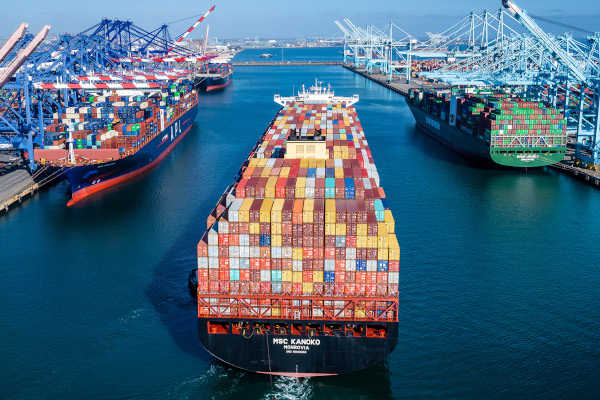Major U.S. container ports are entering a period of historically low cargo volumes as the holiday season winds down. However, attacks on cargo ships in the Red Sea and continued delays at the Panama Canal may shake up this year’s usual winter lull.
Asian cargo bound for East and Gulf Coast ports that was previously being rerouted from Panama to the Suez Canal is now being shipped around the Cape of Good Hope in Africa. The National Retail Federation estimates this is adding five or six days to the month-long trip from Shanghai to Savannah via the Suez Canal, with some retailers reporting delays as long as two weeks.
As a result, the route from Asia to West Coast ports is looking like a better alternative. A direct voyage from Shanghai to New York via the Cape of Good Hope takes 43 days, according to Sea-Distances.org. A direct voyage from Shanghai to Los Angeles takes about 17 days.
West Coast ports are positioned to benefit from this shorter trip if disruptions in Panama and the Red Sea persist.
“I expect port volumes on the North American West Coast, and inland distribution services from them, to particularly benefit from the disruption should the Panama Canal and Suez Canal constraints continue during Q2-Q3 2024,” said Matt Muenster, chief economist, Breakthrough.
In the near term, however, Muenster said he predicts shippers will choose longer maritime transit times versus the tradeoff of repositioning freight and potentially adding more loading and unloading steps to its transit.
“The impact to networks is growing though, and this cost-benefit analysis keeps adjusting,” he added. “Additional risk-related surcharges, significant spot rate increases, higher fuel costs and emissions, slower transit times, and service disruptions are all unwelcome impacts from these disruptions and will continue to influence transportation decision-making.”
East Coast ports could take the hit
The news is less positive for East Coast ports that are more likely to be affected by these disruptions, said Hackett Associates Founder Ben Hackett. While most cargo headed to the East Coast from Asia comes across the Pacific and through the Panama Canal, some comes through the Red Sea before crossing the Atlantic.
“The number of containers arriving at East Coast ports should not be directly affected if carriers add ships to maintain capacity, but shippers will have to adjust their supply chains to cope with longer transit times,” said Hackett.
As a result, Hackett added that we could see an increase of Asian cargo arriving at West Coast ports and then shipped east via intermodal rail—at a significant cost to the shipper.
“Doing so is costly and does not save that much time,” said Hackett. “As might be expected, carriers are passing on the additional voyage costs and then some.”
U.S. ports prepared to support growth
Whatever these global uncertainties bring over the next few months, North American ports are well-equipped to handle further disruptions. Labor at the ports has returned to normal levels, and economic growth is expected to ease as the country enters a presidential election year.
“I do not think the disruptions at the canals will lead to port disruption and bottlenecking to the extent experienced during the pandemic,” said Muenster. “Economic growth will be slower during 2024 than it was during 2021-2022, and supply chains are better equipped for these disruptions.”
SC
MR


More Global Trade
- Made in Mexico, manufactured by China
- Retail sales see gains in October, reports Commerce and NRF
- Geopolitical readiness in supply chains: Strategic challenges for leaders
- Tariffs, taxes and trade: The impact of Trump’s reelection on the supply chain
- Aggregators sitting on the throne of Africa’s e-commerce supply chains: What lessons can we learn?
- Cross-border transport 2024: Navigating the surge
- More Global Trade
Latest Podcast

 Explore
Explore
Topics
Procurement & Sourcing News
- Made in Mexico, manufactured by China
- Retail sales see gains in October, reports Commerce and NRF
- Geopolitical readiness in supply chains: Strategic challenges for leaders
- With capacity to spare, logistics real estate demand remains subdued
- Tariffs, taxes and trade: The impact of Trump’s reelection on the supply chain
- How to improve demand forecasts for new product families
- More Procurement & Sourcing
Latest Procurement & Sourcing Resources

Subscribe

Supply Chain Management Review delivers the best industry content.

Editors’ Picks




